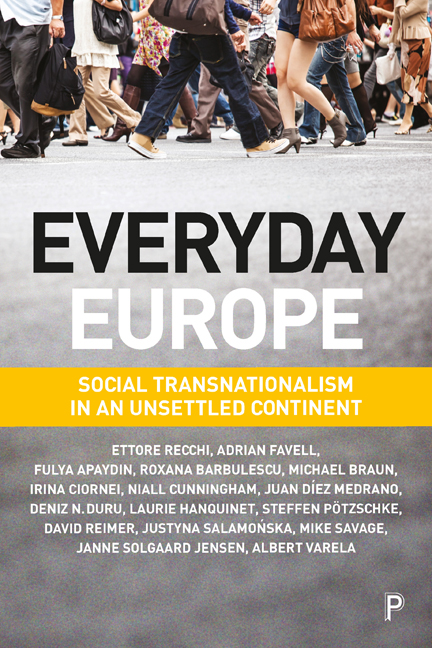Book contents
- Frontmatter
- Contents
- List of tables and figures
- Notes on contributors
- Acknowledgements
- Introduction: Social transnationalism in an unsettled continent
- one Cartographies of social transnationalism
- two The social structure of transnational practices
- three Cultural boundaries and transnational consumption patterns
- four Social transnationalism and supranational identifications
- five Explaining supranational solidarity
- six Narratives and varieties of everyday transnationalism
- seven Understanding Romanians’ cross-border mobility in Europe: movers, stayers and returnees
- eight Transnational Turkey: the everyday transnationalism and diversity of Turkish populations in Europe
- Epilogue Is social transnationalism fusing European societies into one?
- Methodological appendix
- Index
Epilogue - Is social transnationalism fusing European societies into one?
Published online by Cambridge University Press: 19 April 2022
- Frontmatter
- Contents
- List of tables and figures
- Notes on contributors
- Acknowledgements
- Introduction: Social transnationalism in an unsettled continent
- one Cartographies of social transnationalism
- two The social structure of transnational practices
- three Cultural boundaries and transnational consumption patterns
- four Social transnationalism and supranational identifications
- five Explaining supranational solidarity
- six Narratives and varieties of everyday transnationalism
- seven Understanding Romanians’ cross-border mobility in Europe: movers, stayers and returnees
- eight Transnational Turkey: the everyday transnationalism and diversity of Turkish populations in Europe
- Epilogue Is social transnationalism fusing European societies into one?
- Methodological appendix
- Index
Summary
Introduction: one Europe for whom?
‘Europe’ – as such – is the main intercontinental travel destination of Chinese tourists. In 2016, 12 million visited from Mainland China, six times their number in 2000 (Artl 2016). The rise continues, as 2018 was announced by the EU and the Chinese government as the ‘EU–China Year of Tourism’ (whatever this may mean). More sophisticated and diversified than in the early 2000s, still the majority of Chinese tourists set foot on the Old Continent as part of an organised group package trip. On average they stay between one and three nights per country – overall visiting between five and ten different nations (Croce 2016). The Schengen visa (which costs €60) favours such cross-border travel, as it allows access to more than 20 countries with a single authorisation, and removes the perception of frontiers. On their way from one destination to the other, typically under strict timelines, Chinese tourists hardly have the impression of crossing national borders. In their eyes, Europe is one.
Contrast this with the experience of European movers. Their perceptions along with their hosts’ resonate with persisting cultural differences, language barriers, diverse cuisines, bureaucratic rules, sexual and family mores. It is true that passport controls have been removed since the 1990s (but have been reinstated more or less systematically since the Islamist attacks in France and Belgium in 2015) and most benefits of European citizenship have resisted the anti-EU wave that culminated in the Brexit referendum of 2016 (although not entirely: Carmel and Paul 2013; Heindlmaier and Blauberger 2017), but still EU citizens moving across member states can hardly overlook national borders. At the very least, they must not forget to bring medical insurance (or the European Health Insurance Card) and plug adapters with them, as well as subscribing to roaming plans for their smartphones and laptops in order to be able to connect to the internet. In short, other member states are still ‘abroad’ for the average European. Experientially, Europe continues to be made up of separate national societies, rather than being a ‘society’ in its own right.
- Type
- Chapter
- Information
- Everyday EuropeSocial Transnationalism in an Unsettled Continent, pp. 255 - 290Publisher: Bristol University PressPrint publication year: 2019

